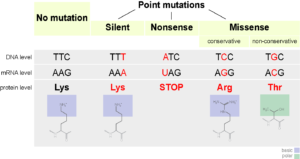Types of Mutations
The DNA sequence of a gene can be altered in a number of ways. Gene mutations have varying effects on health, depending on where they occur and whether they alter the function of essential proteins. The types of mutations include:
- Silent mutation: Silent mutations cause a change in the sequence of bases in a DNA molecule, but do not result in a change in the amino acid sequence of a protein (Figure 1).
- Missense mutation: This type of mutation is a change in one DNA base pair that results in the substitution of one amino acid for another in the protein made by a gene (Figure 1).
- Nonsense mutation: A nonsense mutation is also a change in one DNA base pair. Instead of substituting one amino acid for another, however, the altered DNA sequence prematurely signals the cell to stop building a protein (Figure 1). This type of mutation results in a shortened protein that may function improperly or not at all.

- Insertion or Deletion: An insertion changes the number of DNA bases in a gene by adding a piece of DNA. A deletion removes a piece of DNA. Insertions or deletions may be small (one or a few base pairs within a gene) or large (an entire gene, several genes, or a large section of a chromosome). In any of these cases, the protein made by the gene may not function properly.
- Duplication: A duplication consists of a piece of DNA that is abnormally copied one or more times. This type of mutation may alter the function of the resulting protein.
- Frameshift mutation: This type of mutation occurs when the addition or loss of DNA bases changes a gene’s reading frame. A reading frame consists of groups of 3 bases that each code for one amino acid. A frameshift mutation shifts the grouping of these bases and changes the code for amino acids. The resulting protein is usually nonfunctional. Insertions, deletions, and duplications can all be frameshift mutations.

- Repeat expansion: Nucleotide repeats are short DNA sequences that are repeated a number of times in a row. For example, a trinucleotide repeat is made up of 3-base- pair sequences, and a tetranucleotide repeat is made up of 4-base-pair sequences. A repeat expansion is a mutation that increases the number of times that the short DNA sequence is repeated. This type of mutation can cause the resulting protein to function in a completely different way than it would have originally.
References
“Mutations and Health” by U.S. National Library of Medicine is in the Public Domain

